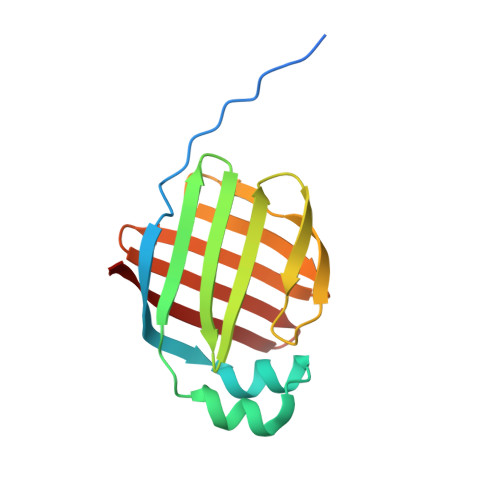FABP1 controls hepatic transport and biotransformation of Delta 9 -THC.
Elmes, M.W., Prentis, L.E., McGoldrick, L.L., Giuliano, C.J., Sweeney, J.M., Joseph, O.M., Che, J., Carbonetti, G.S., Studholme, K., Deutsch, D.G., Rizzo, R.C., Glynn, S.E., Kaczocha, M.(2019) Sci Rep 9: 7588-7588
- PubMed: 31110286
- DOI: https://doi.org/10.1038/s41598-019-44108-3
- Primary Citation of Related Structures:
6MP4 - PubMed Abstract:
The increasing use of medical marijuana highlights the importance of developing a better understanding of cannabinoid metabolism. Phytocannabinoids, including ∆ 9 -tetrahydrocannabinol (THC), are metabolized and inactivated by cytochrome P450 enzymes primarily within the liver. The lipophilic nature of cannabinoids necessitates mechanism(s) to facilitate their intracellular transport to metabolic enzymes. Here, we test the central hypothesis that liver-type fatty acid binding protein (FABP1) mediates phytocannabinoid transport and subsequent inactivation. Using X-ray crystallography, molecular modeling, and in vitro binding approaches we demonstrate that FABP1 accommodates one molecule of THC within its ligand binding pocket. Consistent with its role as a THC carrier, biotransformation of THC was reduced in primary hepatocytes obtained from FABP1-knockout (FABP1-KO) mice. Compared to their wild-type littermates, administration of THC to male and female FABP1-KO mice potentiated the physiological and behavioral effects of THC. The stark pharmacodynamic differences were confirmed upon pharmacokinetic analyses which revealed that FABP1-KO mice exhibit reduced rates of THC biotransformation. Collectively, these data position FABP1 as a hepatic THC transport protein and a critical mediator of cannabinoid inactivation. Since commonly used medications bind to FABP1 with comparable affinities to THC, our results further suggest that FABP1 could serve a previously unrecognized site of drug-drug interactions.
Organizational Affiliation:
Department of Biochemistry and Cell Biology, Stony Brook University, Stony Brook, New York, 11794, USA. [email protected].
















